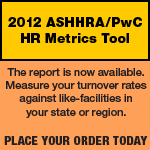ASHHRA eNews Pulse
ASHHRA
ASHHRA e-News Brief: October 2012Leading People Through Change was the topic of this year’s ASHHRA Annual Conference & Exposition and the theme of our year. Some of what you read here will sound familiar if you were one of the lucky ones who had an opportunity to attend the conference. If you didn’t have a chance to join us this year, you missed out on great speakers and an overall great conference. Don’t put off your plans. Take steps now to attend next year’s ASHHRA Annual Conference & Exposition at the Marriott Wardman in Washington, D.C., Sept. 28 through Oct. 1, 2013.
So what did you miss? A great presentation by Tom Flick, former Rose Bowl Champion and successful NFL quarterback, started off our conference. Tom wisely pointed out, "If we are not getting better faster than the competition, we are losing ground." In other words, change is here and leading people through it is the only way we are going to get better than the competition each and every day. Tom shared two challenges leaders face: complacency and a sense of true urgency. In his presentation he provided us with some great advice for the future. He recommended that we chase big dreams, live by our principles, and lead the way. This quick summary does not do Tom’s presentation justice. If you have an opportunity to see Tom present at a meeting in the future, sign right up. He was an excellent and engaging speaker, and he captured the essence of true leadership and our roles in exemplifying this leadership in our organizations.
Throughout the conference we had an opportunity to hear many speakers including some former ASHHRA presidents. Molly Seals, senior VP with Catholic Health Partners/Humility of Mary Health Partners, spoke on the best models for building tomorrow’s frontline hospital workforce. Bob Walters, corporate director, Health First, Inc., led a thought leader forum on physician integration. Bob Riney, president and COO, Henry Ford Health System, partnered with two other CEOs: Ken Lukhard, president, Advocate Christ Medical Center, and Michael Robinson, CEO and senior VP, Bon Secours Memorial Regional Medical Center. Together they provided an enlightening panel discussion on innovative strategies that transform care. The work going on in their organizations is an inspiration to us all and a bird’s eye view into our future.
There were over 180 exhibits this year and some great vendor partners helping us with solutions in all areas of human resources and some industry-specific solutions not solely restricted to human resources. Education, child care, retirement, compensation, benefits, consulting, financial wellness, IT solutions, onboarding... all areas of interest were represented at the exhibits. Literally, one-stop shopping for HR tools that you could touch and feel in an environment where you could ask lots of questions.
We also had a great opportunity to visit with old friends, celebrate wins, recharge our batteries, learn from each other, and just have a little fun. This message was brought home to us as we closed the conference with a bang! Carson Kressley, star of the hit Emmy award-winning series, Queer Eye for the Straight Guy, entertained us with his humor and candor. We learned that we cannot lead others through change if we are not confident in ourselves first. This might mean an annual hair and makeup physical, or eating right and staying fit, or just simply taking time out for ourselves every once in a while. Carson’s advice for changing how we feel about ourselves sent us home in great spirits and ready to Lead People Through Change.
Leading People Through Change,
Irma L. Pye, SPHR
ASHHRA 2012 President
Senior Vice President & CHRO
Valley Baptist Health System
Harlingen, Texas
Visit http://sso.aha.org/opensso/cdcservlet?goto=http%3A%2F%2Fwww.ashhra.org%3A80%2Fmember%2Fhc_labor_report.shtml&RequestID=541512952&MajorVersion=1&MinorVersion=0&ProviderID=http%3A%2F%2Fs259722ch3vl49.uschcg6.savvis.net%3A80%2Famagent&IssueInstant=2012-10-09 to view the full article online.
Health care recruiters serve two important customer groups: candidates and hiring managers. Unfortunately, it can be impossible for recruiters to meet employment and candidate satisfaction goals if hiring managers don’t fulfill their role in the hiring process. Successful health care organizations recognize that building a quality workforce is a team effort between recruiters and hiring managers, and both parties must assume responsibility for the part they play.
Visit http://www.naylornetwork.com/ahh-nwl/pdf/McNeil-Holding_Your_Hiring_Managers_Accountable_final_051712.pdf to view the full article online.
After a months-long slump, the September jobs report from the Bureau of Labor Statistics showed signs of vigor. A surge in job creation within the health care sector helped push the national unemployment rate to its lowest point in 43 months.
SOURCE: HEALTHLEADERS MEDIA
Visit http://www.healthleadersmedia.com/content/HR-285183/Healthcare-Job-Growth-Boosts-Employment-Stats to view the full article online.
Physicians are altering their work habits in a variety of ways to work less with more becoming hospital employees or cutting back on hours their practices are open and limiting the number of patients they will see.
SOURCE: FORBES
Visit http://www.forbes.com/sites/brucejapsen/2012/10/08/doctors-working-less-as-obamacare-looms-to-bring-them-more-paying-patients/ to view the full article online.
Compensation for the CEOs, presidents and executive directors of the nation's highest-grossing non-profit hospitals always represents one extreme of the health care pay spectrum, and in 2010, their average pay easily exceeded seven figures.
SOURCE: BECKER’S HOSPITAL REVIEW
Visit http://www.beckershospitalreview.com/compensation-issues/ceo-compensation-of-the-25-top-grossing-non-profit-hospitals.html to view the full article online.
The Rhode Island Department of Health adopted regulations that require all health workers in the state to receive flu vaccinations. The vaccinations are mandatory for all workers, students, trainees, and volunteers who come into direct contact with patients, unless they have a medical exemption from their provider or if they are opposed to it and submit a form, according to the state health department.
SOURCE: FIERCE HEALTHCARE
Visit http://www.fiercehealthcare.com/story/states-mandate-flu-vaccinations-health-workers/2012-10-09 to view the full article online.
SOURCE: PENN NURSING SCIENCE
Visit http://www.nursing.upenn.edu/sia/Pages/Nurses-Assessment-of-Hospital-Quality.aspx to view the full article online.
In our annual Industry Survey, only 10 percent of CEOs described their organization's physician recruitment and retention efforts as very strong and just 38 percent characterized it as strong. Another 19 percent rated it as weak or very weak. What trends are you seeing, and what are the actionable strategies to achieving an exceptional physician recruitment and retention program?
SOURCE: HEALTHLEADERS MEDIA
Visit http://www.healthleadersmedia.com/content/LED-285076/Strategies-for-Securing-Physician-Talent to view the full article online.
Doctors are working less, seeing fewer patients, and many would quit if they could, a sweeping survey of 13,575 physicians from across the nation shows. The survey, A Survey of America's Physicians: Practice Patterns and Perspectives, was commissioned by The Physicians Foundation. It is the latest, and perhaps the largest and most comprehensive of a number of surveys that have identified wide, deep and increasing discontent among the nation's physicians regardless of their age, gender, specialty, location, or employment status.
SOURCE: HEALTHLEADERS MEDIA
Visit http://www.healthleadersmedia.com/content/PHY-284829/6-in-10-Physicians-Would-Quit-Today to view the full article online.
When the Affordable Care Act’s insurance mandate takes effect in 2014, some 30 million newly covered patients – people generally treated in emergency rooms now – will be shopping for doctors. That’s a problem because the U.S. has 15,230 fewer primary-care physicians than it needs, according to the U.S. Department of Health and Human Services.
SOURCE: BLOOMBERG BUSINESSWEEK
Visit http://www.businessweek.com/articles/2012-09-27/a-looming-u-dot-s-dot-doctor-shortage to view the full article online.
For many physicians, financial planning for retirement begins during the first years of practice. But what about preparing for the psychological transition to retirement – that inevitable time when the practice of medicine is no longer the primary focus of your time and energy?
SOURCE: AMEDNEWS.COM
Visit http://www.ama-assn.org/amednews/2012/10/08/bisa1008.htm to view the full article online.
A high-performing system not only efficiently coordinates care and uses meaningful technology, but it also rewards its providers for carrying out those efforts.
SOURCE: FIERCE HEALTHCARE
Visit http://www.fiercehealthcare.com/story/7-traits-high-performing-system/2012-10-05 to view the full article online.
The health care leader of the future will need to get things done while navigating a difficult, changing environment. Margins and valuation multiples are shrinking. The health care leader of the future will identify and adapt to a new hospital business model to be successful. Five qualities will define dynamic leadership in the future.
SOURCE: BECKER’S HOSPITAL REVIEW
Visit http://www.beckershospitalreview.com/hospital-management-administration/tomorrows-top-healthcare-leaders-5-qualities-of-the-healthcare-leader-of-the-future.html to view the full article online.
Following evidence-based practices is critical for preventing harm in a health care setting. However, what happens when there are no evidence-based practices? Hospitals are being called upon to innovate and create patient safety protocols to fill gaps in the literature and adapt existing practices to different environments.
SOURCE: BECKER’S HOSPITAL REVIEW
Visit http://www.beckershospitalreview.com/hospital-physician-relationships/6-steps-to-encourage-patient-safety-innovation-at-hospitals.html to view the full article online.
Dr. Alvin Rajkomar was doing rounds with his team at the University of California, San Francisco Medical Center when he came upon a puzzling case: a frail, elderly patient with a dangerously low sodium level. As a third-year resident in internal medicine, Dr. Rajkomar was the senior member of the team, and the others looked to him for guidance. An infusion of saline was the answer, but the tricky part lay in the details. Concentration? Volume? Improper treatment could lead to brain swelling, seizures or even death. Dr. Rajkomar had been on call for 24 hours and was exhausted, but the clinical uncertainty was "like a shot of adrenaline," he said. He reached into a deep pocket of his white coat and produced not a well-thumbed handbook but his iPhone.
SOURCE: THE NEW YORK TIMES
Visit http://www.nytimes.com/2012/10/09/science/redefining-medicine-with-apps-and-ipads-the-digital-doctor.html?ref=health&_r=1& to view the full article online.











